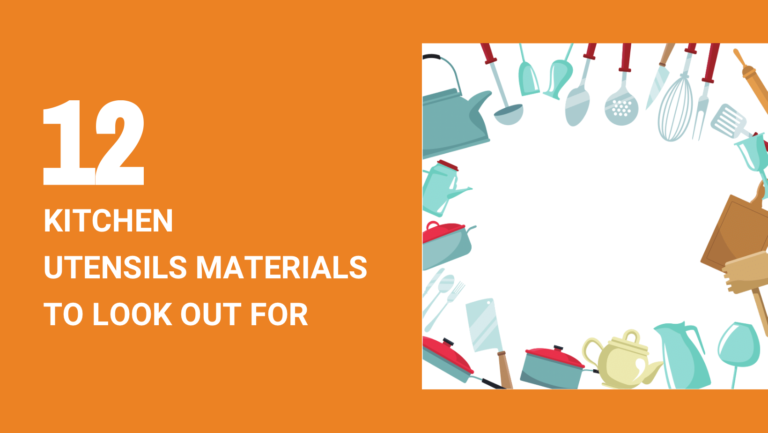When it comes to cooking, the materials you use matter just as much as the ingredients.
From spatulas to soup ladles, kitchen utensils come in all shapes, sizes, and more importantly – materials.
But not all materials are created equal, and some may even pose health risks if you’re not careful.
With growing concerns around toxic chemicals like BPA, PFOA, and heavy metals, more people are making the switch to safe, non-toxic kitchen utensils.
Whether you’re cooking at home or sourcing products for your business, understanding the pros and cons of each material can help you make smarter, safer choices.
In this guide, we’ll break down the top kitchen utensil materials, highlight which ones are safe, durable, and non-toxic and point out a few you may want to avoid altogether.
Best Kitchen Utensil Materials by Use
| Cooking Task | Recommended Material |
| High-heat cooking (e.g. frying, grilling) | Stainless steel, cast iron |
| Non-stick cookware | Silicone, wood, bamboo |
| Baking (e.g. spatulas, whisks) | Silicone, stainless steel |
| Gentle stirring & serving | Wood, bamboo |
| Heavy-duty mixing or scraping | Stainless steel, cast iron |
| Microwave-safe tools | Glass, silicone |
| Eco-friendly options | Bamboo, wood |
| Beginner-safe / lightweight use | Silicone, plastic (low-heat use only) |
| Avoiding scratches on cookware | Silicone, wood, nylon |
What Makes Kitchen Utensils Non-Toxic?
Non-toxic kitchen utensils are made from materials that don’t leach harmful chemicals into your food – even when exposed to high heat, moisture, or acidic ingredients.
With growing awareness around health and food safety, more people are choosing utensils that are free from toxic compounds and safe for everyday cooking.
Here’s what defines a non-toxic utensil:
- Free from harmful chemicals: Materials should be free of BPA, phthalates, PFOA, PFAS, and other toxins that could pose long-term health risks.
- Heat resistance: Utensils should be able to handle high temperatures without melting, breaking down, or releasing harmful fumes, especially when used on hot pans or in the oven.
- Food-safe and non-reactive: Safe materials won’t react with acidic ingredients, absorb flavors, or stain over time. This is important for preserving both food safety and flavor.
- No toxic coatings or glues: Avoid utensils with surface coatings or adhesives that could wear off and contaminate your food. Non-toxic options either skip coatings or use food-safe alternatives.
- Stable under long-term use: Non-toxic doesn’t just mean “safe today” it means the material stays stable after months or years of repeated use, hand-washing, or dishwasher cycles.
Safe & Non-Toxic Kitchen Utensil Materials
Stainless Steel
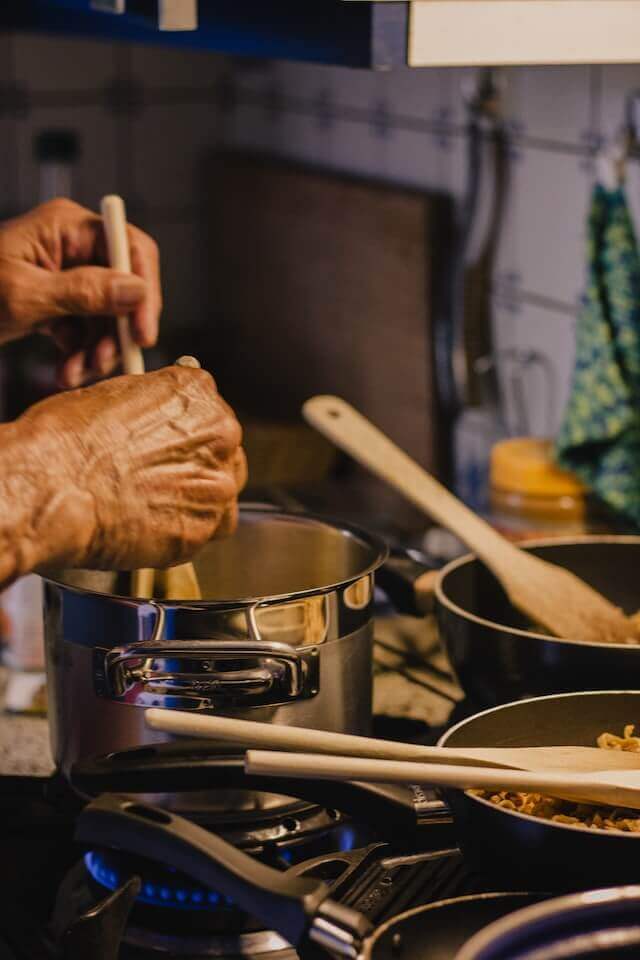
Stainless steel is one of the best materials for cooking utensils. It is an alloy of carbon, iron, and chromium. The chromium protects it from corrosion, making it a durable and robust material for kitchen utensils.
Stainless steel has become a favorite in the market due to its durability, eco-friendliness, and, most importantly, safety. Pure stainless steel poses no health risks, meaning you can enjoy your cooking without worries.
In addition, aluminum and copper are sometimes added to the alloy to boost its conductivity.
Pros
- Stainless steel is corrosion-resistant. The chromium in the alloy forms an oxide coating that prevents it from rust.
- If you want utensils that will last a lifetime, then stainless steel is the material to go for. Its strength and rust-free quality allow it to last longer.
- It can sustain high temperatures, hence it is oven-safe.
- Stainless steel is non-reactive, meaning it does not react with food or washing products.
- It is a recyclable material that contributes to environmental conservation.
- It is hygienic, easy to clean (dishwasher safe), and non-porous.
Cons
- It is costly compared to other materials.
- Pure stainless steel is not a good conductor of heat, hence, aluminum and copper are added to increase.
- It can get too hot to handle, hence you should use protective gear.
Care Tip
Although stainless steel is dishwasher safe, hand washing helps maintain its shine and finish over time. Avoid abrasive steel wool, which can scratch the surface.
Wood
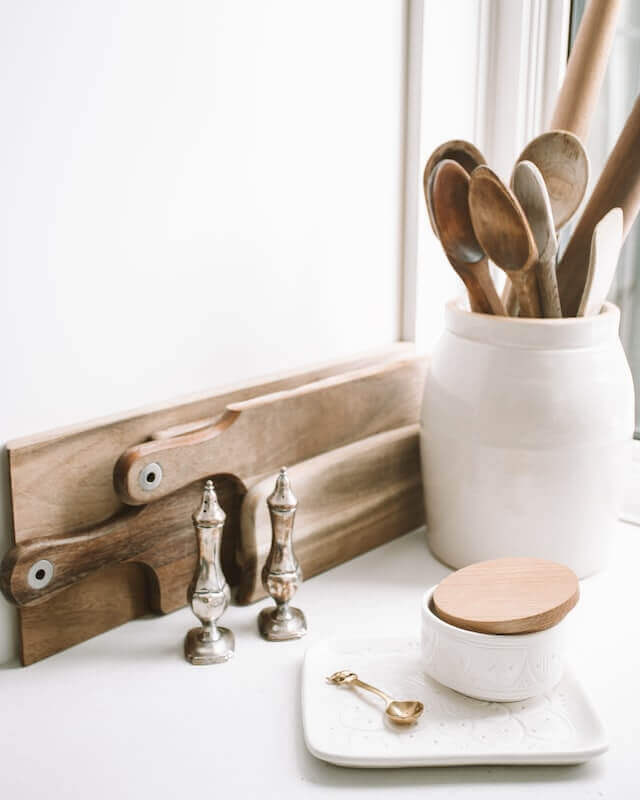
Wood is one of the oldest and most traditional materials used in kitchens — and it’s still a favorite today. From spoons and spatulas to mixing bowls and salad tongs, wooden utensils are known for their natural look, gentle touch, and food-safe properties.
While wood isn’t ideal for high-heat cooking (like frying or baking), it’s excellent for stirring, serving, and prepping, especially with non-stick or delicate cookware. Among the many types of wood, teak is a top choice thanks to its durability and resistance to moisture.
Pros
- Wood is 100% biodegradable. By using wooden utensils, you are positively contributing to eco-friendly solutions.
- It has antimicrobial properties, meaning it is a hygienic option for your kitchen.
- It is durable; wood can be used for decades without wearing out.
- It is safe to use as it does not react with any products or food.
- Wood does not scratch surfaces and other utensils.
Cons
- Wood can break easily when mishandled. Also, food can get stuck in broken surfaces leading to hygiene issues.
- It picks up smells.
- It is porous, meaning it absorbs water and other liquids.
- It is not dishwasher-friendly.
Care Tip
Always hand wash wooden utensils and dry them immediately. Avoid soaking, and occasionally apply food-grade mineral oil to prevent drying or cracking.
Glass

If you are going for elegance in your kitchen, then purchasing glass utensils will give you the appeal you are looking for. Glass is very versatile in the kitchen since you can use it for cooking, heating, serving, stirring, and more uses.
It can be used to make most, if not all, kitchenware. Moreover, glass is safe to use in terms of health. Being inert, unlike plastic and other materials, you can safely use it in the microwave.
Pros
- Glass utensils can be used in high temperatures and retain heat for longer. Your food will not get cold easily.
- If handled properly, glass can last more than 10 years while still in perfect condition.
- It is non-porous, hence it can safely handle liquids.
- It is dishwasher-friendly.
- Glass is completely recyclable; it can be repurposed to make other items.
- It is unreactive, whether it’s food or other chemicals.
- It is a good conductor of heat.
Cons
- Glass is a very fragile material since it can break easily. Proper care is needed when handling glass utensils. Also, a sudden temperature change can break it.
- It is a bit heavy compared to other materials.
Care Tip
Avoid exposing glass to sudden temperature shifts (like moving from freezer to oven). Use tempered or borosilicate glass for better heat resistance.
Silicone
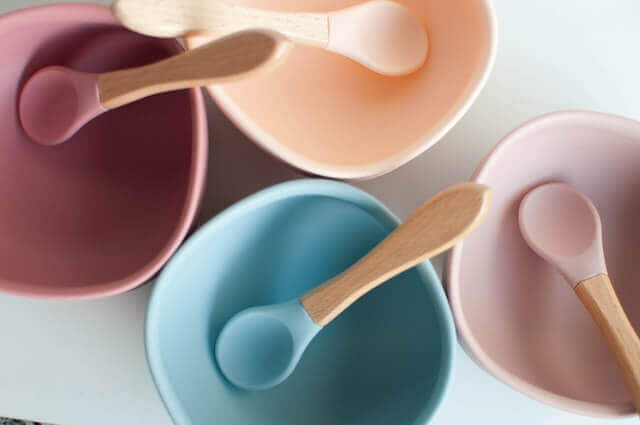
Silicone has become one of the most popular non-toxic materials for kitchen utensils, especially for tools like spatulas, whisks, and scrapers.
Made from a flexible polymer blend that includes silicon, carbon, and oxygen, food-grade silicone is FDA-approved and heat-resistant up to around 450°F (232°C).
It’s gentle on non-stick cookware, easy to clean, and available in a wide range of colors and styles.
Pros
- Since it’s rubber, silicone guarantees no scratches to your pans and cookware.
- It is easy to clean and maintain. It is dishwasher safe.
- It is cool to the touch since it does not conduct heat.
- It is flexible, making its usage easy and convenient.
- It is inert, hence does not react with food.
- It is recyclable.
Cons
- Silicone may release some chemicals when exposed to extremely high temperatures.
- Even though it is recyclable, finding a recycling center that deals with it might be hard.
- It holds smells if not properly cleaned. Also, proper cleaning is needed to prevent staining.
- Some brands use plastic fillers on their silicone products; hence, work with sourcing agents to assist in finding brands with high-quality silicone products.
Care Tip
Buy from trusted suppliers or verified manufacturers to avoid low-quality silicone with fillers. Wash thoroughly to remove any trapped oils or food smells.
Bamboo

Bamboo has become a go-to material for eco-conscious kitchens, and for good reason. As one of the fastest-growing plants on Earth, bamboo is highly renewable and widely considered more sustainable than traditional wood.
Compared to wooden utensils, bamboo absorbs less moisture, making it less prone to cracking and more durable over time. You’ll commonly see bamboo used for cutting boards, spoons, spatulas, trays, and plates.
Pros
- Bamboo is a natural antimicrobial, promoting good hygiene in the kitchen.
- It does not absorb as much moisture as wood.
- It is a sustainable material.
- It is cost-effective.
- Bamboo utensils are durable but still lightweight.
- They will not scratch your favorite pans.
Cons
- Bamboo is not fully moisture-resistant. You should avoid the dishwasher.
- Although it is durable, caution should still be taken when using bamboo as it can break.
- Cannot be used for heating or cooking food.
Care Tip
Always hand wash bamboo utensils and dry them immediately. Avoid soaking, and apply food-safe mineral oil regularly to maintain the finish.
Ceramic
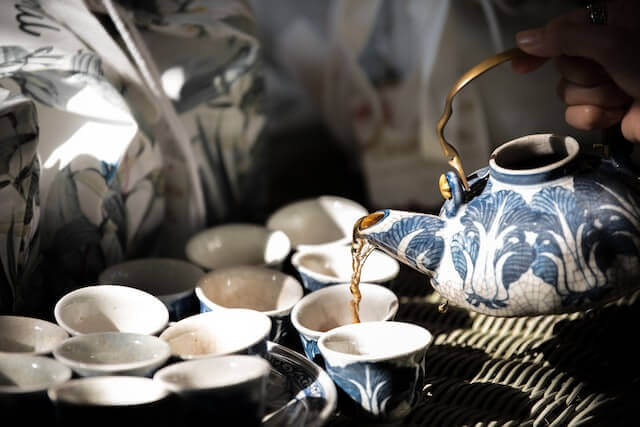
Ceramic utensils are made from a blend of natural materials like clay, water, and earth minerals. These are shaped, fired at high temperatures, and sometimes coated for added durability.
Depending on the manufacturing process, ceramic utensils can be pure ceramic or metal utensils coated with a ceramic layer.
Ceramic is widely appreciated for being non-toxic, non-reactive, and visually elegant, especially when used in serving dishes or bakeware.
Pros
- Ceramic is safe to use as it does not react with anything; food or chemicals.
- It is long-lasting if handled with proper care.
- It is scratch-resistant.
- It is good at retaining heat for long periods and distributing it evenly.
- It does not absorb any smell or retain stains.
Cons
- It is easily cracked if there is a sudden temperature change.
- It is an expensive option for utensils.
- Ceramic-coated utensils can be harmful since it is metals coated with ceramic. The metals underneath may contain toxic chemicals.
Care Tip
Use soft utensils with ceramic surfaces to avoid chipping. Avoid sudden temperature changes (e.g., from fridge to oven), and hand wash when possible to extend the life of the finish.
Cast Iron
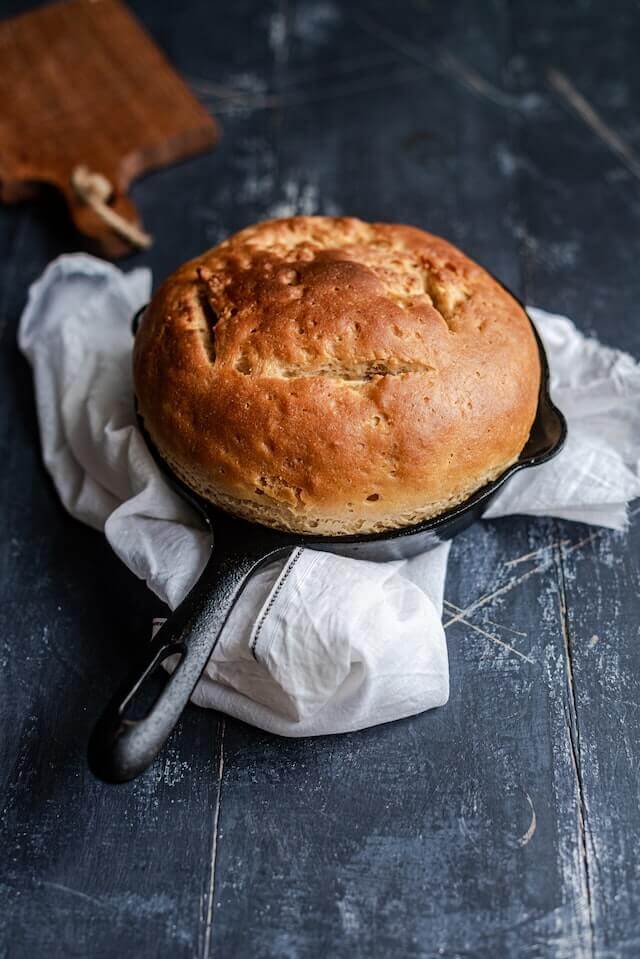
Unlike other materials used for utensils, cast iron has been proven to release iron into your food which is helpful for your health. Cast iron has traces of silicon, manganese, sulfur, carbon, and sometimes phosphorus.
It is a hard material and also non-malleable. Cast iron utensils are either uncoated or enameled. Enameled means it is coated with enamel to help prevent rusting and permit vigorous cleaning.
Pros
- It releases iron into food. Iron helps prevent diseases such as anemia and has many more uses in the body.
- It is safe to use in the oven; it can withstand high temperatures and retain heat.
- Cast iron is durable and lasts longer when used properly.
Cons
- Uncoated cast iron utensils are not rust-resistant.
- It is a heavy-weight material, unlike most materials used in making utensils.
- The uncoated one can change the taste and color of acidic foods since it is reactive.
- It is not the best conductor of heat (conducts unevenly and slowly).
Care Tip
Uncoated cast iron should be seasoned regularly and dried thoroughly after washing to prevent rust. Avoid using soap on traditional cast iron — instead, clean with hot water and a brush.
Other Common Kitchen Utensil Materials
Copper
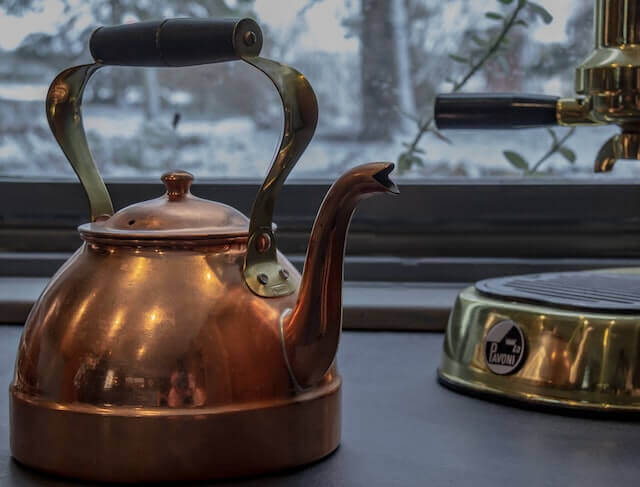
Being a pricey material for utensils, it is not as common as other kitchen utensils materials. However, copper utensils are quite common with chefs (professional cooks). Copper is a very conductive element.
It is added to other materials, such as stainless steel, to increase their conductivity. This is why most professional cooks use copper utensils since they can distribute heat evenly.
Pros
- It is a safe option to use in the oven.
- Copper cooking pots distribute heat evenly, ensuring your food comes out as expected.
- Copper has antimicrobial properties, helping with sanitary issues in the kitchen.
Cons
- It is high maintenance. Copper utensils require frequent polishing to retain their shiny appearance.
- It is easily scratched.
- Copper can leak into food, which may lead to health issues.
- It is a very reactive element, hence reacting with certain foods, natural minerals, and chemicals.
Care Tip
Avoid using abrasive sponges on copper surfaces. Use a copper-safe polish to maintain its shine, and never use unlined copper utensils directly with acidic foods.
Aluminum
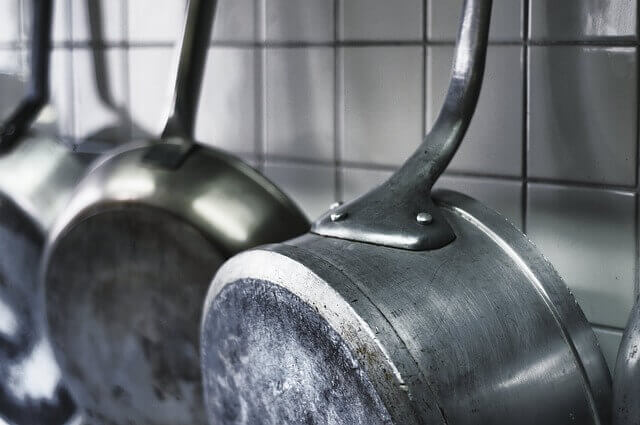
Aluminum is also a popular material for kitchen utensils. The best one to use is the treated one to avoid aluminum from leaking into food. When looking for these utensils, go for one that is anodized, non-stick, and scratch-resistant.
This way, you will be sure of your safety from aluminum ingestion.
Pros
- Aluminum is a good conductor of heat; its utensils are among the best for cooking and heating.
- They are non-sticky, making them easy to wash and maintain.
- Aluminum is a lightweight material.
Cons
- Aluminum reacts with food changing its taste and smell.
- Utensils coated with aluminum can release harmful chemicals into food, causing health issues.
- Utensils made with pure aluminum can’t be used on induction stoves.
Care Tip
Use only wooden, silicone, or nylon utensils on aluminum cookware to prevent scratching. Avoid acidic foods if the aluminum is uncoated.
Nylon
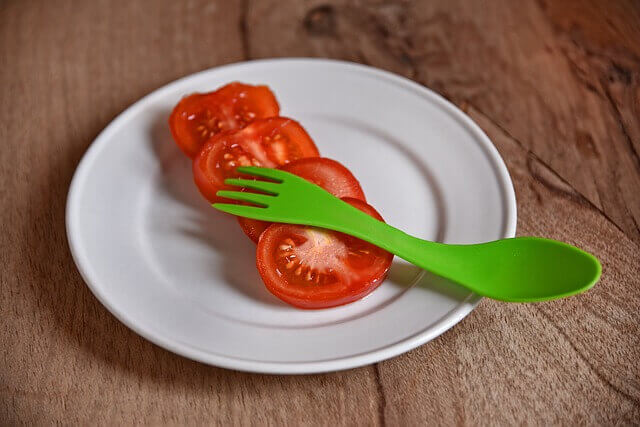
Spoons, turners, tongs, spatulas, and more are some examples of utensils made of nylon. Nylon is a synthetic material that is not a good conductor of heat; hence, it can only be used to make utensils that do not necessarily come into contact with high temperatures.
You should be extra cautious when using nylon utensils as it has a low melting point, meaning you can easily get burned.
Pros
- It has a smooth surface that gives utensils an appealing look.
- It is non-reactive, hence it is safe for food.
- It is dishwasher-friendly.
- Nylon does not scratch pans and surfaces.
- It is a flexible material.
- Has some resistance to smell and stain.
Cons
- Compared to silicone, it cracks easily.
- It is less durable than silicone.
- Nylon is not biodegradable.
- Nylon may release harmful substances into food, especially when exposed to temperatures above 400 degrees Fahrenheit.
Care Tip
Avoid leaving nylon utensils resting in hot pans or near open flames. For safer performance, choose high-heat rated nylon labeled BPA-free.
Plastic
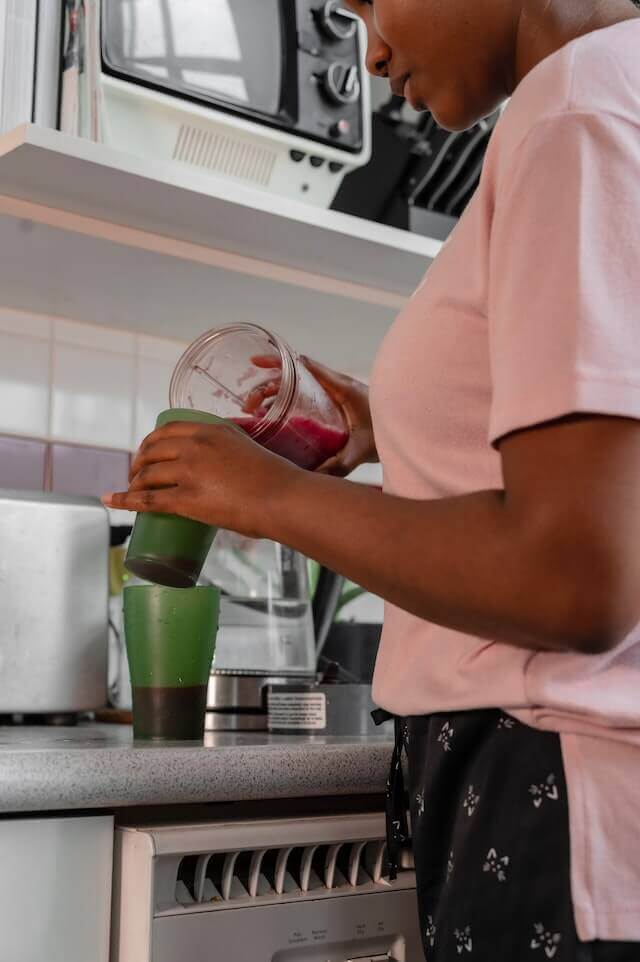
It’s a no-brainer that plastic is a popular material for consumer goods. Plastic utensils are available everywhere and in almost every kitchen worldwide.
Plastic is cheaper; hence, it accounts for a high percentage of kitchenware. There are different kinds of plastic from HDPE, LDPE, PVC, PP, and more. All these plastics are applicable in different ways.
Pros
- They are durable and strong, lasting for long periods.
- Plastic is lightweight, making it easy to use and handle these utensils.
- They do not conduct heat; hence,they are applicable as spoons, cups, dishes, spatulas, containers, etc.
- Plastic is a flexible material; hence you will have access to utensils of various shapes and designs.
- They do not scratch the surfaces of pans and other utensils.
- Plastic utensils are affordable.
Cons
- Plastic is reactive, meaning it can react with some foods or chemicals.
- When used in microwaves and other heat applications, it may release harmful chemicals that may pose health risks.
- They are not biodegradable; however, you can recycle them.
Care Tip
Avoid using plastic utensils for hot food prep. Stick to cold or room-temperature tasks, and never microwave plastic that isn’t labeled as microwave-safe and BPA-free.
Kitchen Utensil Materials to Avoid
Teflon (PTFE-coated utensils)

Teflon, or polytetrafluoroethylene (PTFE), is a synthetic chemical commonly used to create non-stick coatings on cookware and utensils. It’s known for its low-friction, water-resistant, and stain-resistant properties, making it popular in non-stick pans, spatulas, and bakeware.
However, older or low-quality Teflon coatings may contain PFOA (perfluorooctanoic acid), a chemical that has been linked to health risks and has since been banned or phased out in many countries.
While modern PTFE coatings are generally PFOA-free, Teflon still poses risks if overheated or scratched, which can release toxic fumes or flakes into food.
Pros
- It is non-stick, hence food does not stick on surfaces.
- Since it has low friction, utensils last longer. Moreover, less oil is required when using these utensils.
- It is resistant to stains.
- Teflon does not absorb odor.
- It is a premium material that gives utensils an elegant look.
Cons
- Can release toxic fumes if overheated (above 500°F or 260°C)
- Easily scratched — requires soft utensils like silicone or wood
- PFOA (in older coatings) poses serious health concerns
- Not suitable for high-heat cooking or broiling
Care Tip
If you already own PTFE-coated utensils, make sure they’re labeled PFOA-free and avoid high temperatures. For long-term use and peace of mind, many people now prefer non-toxic alternatives like ceramic, stainless steel, or silicone.
How to Choose the Right Supplier for Kitchen Utensils
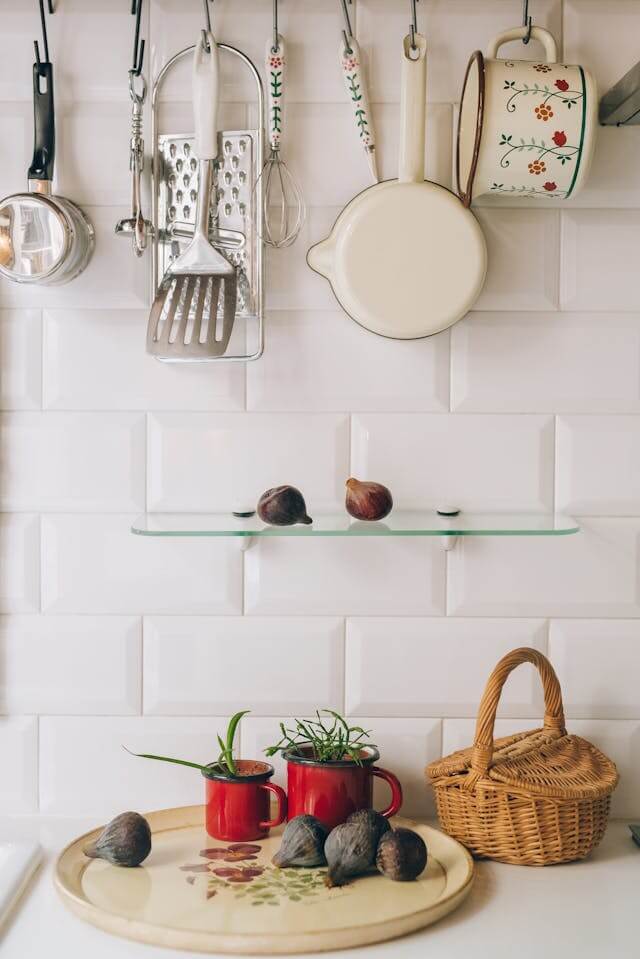
Whether you’re sourcing utensils for retail, private label, or wholesale distribution, choosing the right supplier is just as important as picking the right materials.
The quality, safety, and consistency of your kitchen utensils depend heavily on who you’re working with, especially if you’re importing from overseas manufacturers.
Here are the key factors to consider when selecting a kitchen utensil supplier:
1. Material Transparency
A trustworthy supplier should be upfront about what materials they use and whether those materials meet international food safety standards. Look for:
- Clear material breakdowns (e.g., 304 stainless steel, food-grade silicone, BPA-free plastic)
- Certifications like FDA, LFGB, or SGS
- Willingness to provide samples or lab test reports
2. Production Capabilities
Not all suppliers are equipped to handle the same types of products or volumes. Make sure they can:
- Support your order quantity (small or bulk)
- Offer customizations if needed (logo printing, packaging, color options)
- Maintain consistency across repeated orders
3. Quality Control Standards
Ask how the supplier manages quality assurance. Do they have:
- In-house quality checks?
- Third-party inspection partnerships?
- Sample verification before mass production?
Consistent quality is especially critical for kitchenware that needs to be safe, durable, and food-contact approved.
4. Communication and Responsiveness
Good communication is essential for a smooth sourcing process. A reliable supplier will:
- Respond quickly and clearly
- Provide regular updates during production
- Be transparent about lead times, delays, or issue
Suppliers who are hard to reach during early conversations may not be dependable long-term partners.
5. Price vs. Value
Going for the lowest price might seem appealing — but when it comes to kitchen utensils, cheap materials can lead to:
- Product returns due to breakage or poor quality
- Customer complaints
- Non-compliance with safety regulations
Focus on value: a slightly higher cost per unit may be worth it for better safety, durability, and brand reputation.
Need Help Sourcing Safe, Reliable Kitchen Utensils?
At NicheSources, we work with businesses of all sizes to help them find vetted kitchenware suppliers in China – ones that meet your quality standards, volume needs, and branding goals.
Whether you’re launching a private label line or stocking your store, we’ll help you source better, safer, and smarter.
FAQs about Kitchen Utensils Materials
What Material Are Kitchen Utensil Handles Made Of?
Kitchen utensil handles are typically made from materials that stay cool, offer a comfortable grip, and insulate against heat. Common handle materials include:
- Plastic or polypropylene – Lightweight and cost-effective, but not heat-resistant
- Silicone – Soft, non-slip, and heat-resistant, ideal for non-stick cookware
- Wood – Traditional and comfortable to hold, but not dishwasher safe
- Stainless steel – Durable and long-lasting, though it can get hot if not insulated
- Rubber or thermoplastic grips – Often used in combination with metal for added comfort
The best handle material depends on your priorities — whether it’s heat safety, aesthetics, or durability.
Which Cooking Utensil Material Is Best for Health?
The best materials to make heat-conducting utensils are glass, ceramic, cast iron, and stainless steel. These materials are best since they do not release harmful substances into food, which may cause health issues.
Cast iron releases iron which is helpful, especially for people with iron-deficiency diseases.
Which Is Safer Between Silicone and Nylon?
Both silicone and nylon are good options for non-abrasive utensils. However, silicone has greater qualities than nylon. Silicone is non-reactive, meaning your food will be safe from harmful substances.
Silicone can also withstand more heat than nylon, making it applicable in more areas than nylon. Furthermore, it is easier to clean compared to nylon.
Which Kitchen Utensil Material Should You Avoid?
Although they have advantages, some materials are best to avoid if you can. Some include aluminum, copper nylon, plastic, and Teflon.
These materials are widely used as kitchen utensils, but most release harmful substances that may cause health issues. If their benefits outweigh their risks, then you can use them.
Is Lead Used as a Kitchenware Material?
No. Lead is a toxic element when it gets into the body. Hence, it is not used in food-safe kitchen utensils, but it may still be found in poorly manufactured ceramic cookware or imported utensils with unsafe glazes. This is why it’s critical to:
- Avoid unknown or unverified suppliers
- Look for utensils that are FDA- or LFGB-compliant
- Be cautious with cheap ceramics, especially from unregulated marketplaces
Modern, well-regulated manufacturers do not use lead in utensils or cookware that meet international food safety standards. Besides, lead is not a good conductor of heat.
Wood vs Stainless Steel Cooking Utensils
Both wood and stainless steel are excellent materials for cooking utensils, but they serve different purposes depending on how you cook.
Wood is a great choice for non-stick cookware because it’s gentle and won’t scratch surfaces.
It doesn’t conduct heat, so the handles stay cool while you cook. Wood is also naturally non-reactive and has a warm, traditional feel. However, it can absorb moisture and odors over time, and it requires hand washing and occasional oiling to prevent cracking.
Stainless steel, on the other hand, is ideal for high-heat cooking. It’s incredibly durable, non-reactive, and dishwasher safe.
It can handle tasks that require strength, like flipping heavy foods or stirring thick sauces. The downside is that it can get hot to the touch if not insulated and may scratch delicate cookware if used carelessly.
Use wood for gentle tasks and non-stick pans, and stainless steel for heavy-duty or high-temperature cooking.
Conclusion
With so many options on the market, choosing the right kitchen utensil materials comes down to more than just looks or price. It’s about safety, durability, and long-term performance.
Whether you’re cooking at home or sourcing products for your business, materials like stainless steel, wood, silicone, and bamboo offer a safe and reliable foundation.
At the same time, knowing what to avoid, like poorly made plastic or unsafe non-stick coatings, helps you protect both your health and your customers.
And if you’re a retailer or business owner looking to source high-quality, non-toxic kitchen utensils from trusted manufacturers, working with a sourcing expert can make all the difference.
At NicheSources, we help businesses around the world connect with vetted suppliers in China, ensuring the materials you choose are safe, durable, and suited to your brand’s needs.
From sourcing and customization to quality control and shipping, we take the guesswork out of the process.
Get in touch with our team today and start sourcing kitchenware you can stand behind confidently and safely.
